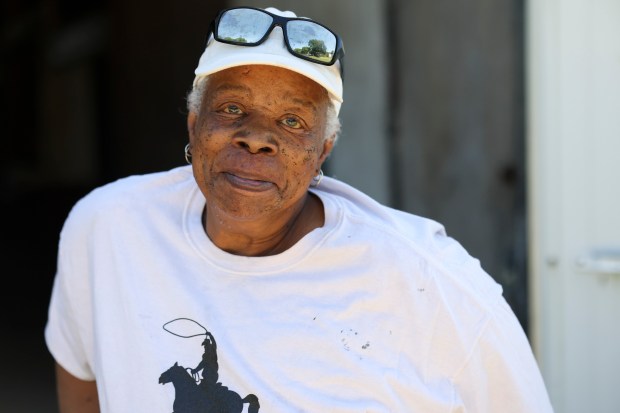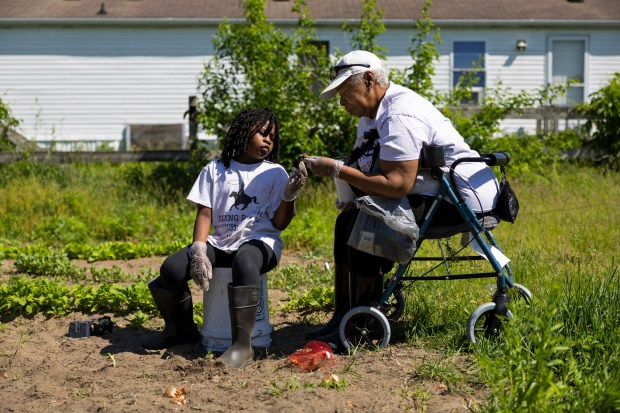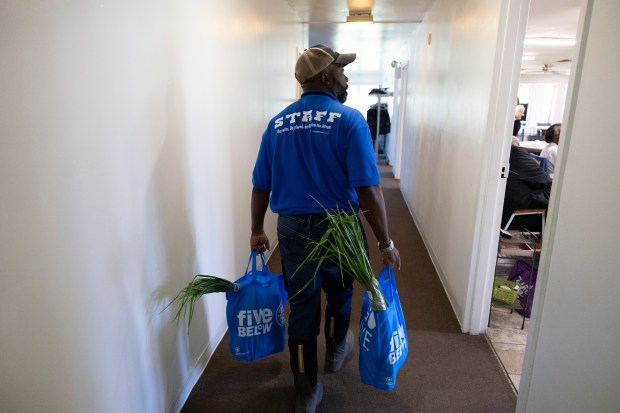A long-delayed state program to get fresh food from local farms to vulnerable communities in Illinois was finally launched in March. But two months later, participants are still struggling to get money from the state to pay farmers and cover program expenses.
“We started with intentions of having money earlier than this and (the farmers) trusted us,” said Brenda Stewart, who runs Run-A-Way Buckers, a community organization distributing produce in eastern Illinois’ Pembroke Township. “I’m thankful they didn’t hold it against us.”
The $30 million federally funded effort aims to rebuild the state’s local food system by connecting underrepresented farmers with communities in need. Even though farms make up 75% of Illinois’ land area, only 5% of the food grown in Illinois is purchased in-state.
When Gov. J.B. Pritzker first announced the nonprofits selected to distribute food in early March, many — including Run-A-Way Buckers — jumped at the opportunity to get started. The announcement was overdue so Black, first-generation and veteran farmers had already ramped up production in anticipation, food was spoiling and families were waiting.
Diane McDonald organizes a network of fellow small-scale Black farmers that has been giving over 100 pounds of produce to Run-A-Way Buckers per week for the last two months. They haven’t been paid for any of it yet, but she isn’t giving up on the program.
“It’s been a crunch. It’s been a lot of out-of-pocket money,” said McDonald. “But, we’re determined to continue until (the state) get(s) it together. It’s a worthy cause, and I appreciate the fact that small farmers are being acknowledged because we’re very important to the agricultural system.”
While farmers have been on the hook, the Illinois Equitable Access Towards Sustainable Systems (IL-EATS) program has been “the talk of the town” among recipients, Stewart said.
The Swiss chard and goat cheese have been big hits at the local senior center, where Run-A-Way Buckers has been sending two dozen bags of locally-grown food each week. The seniors have enjoyed exchanging recipes for these healthy goods that are now available to them.
“It’s bringing out togetherness and a sense of adventure in them, and I love that,” said Velsie Kim Bridges, who runs the center’s nutrition program.
Good intentions, flawed execution
The U.S. Department of Agriculture is funding similar programs that connect underrepresented farmers and underserved communities in every state except Wyoming.
Most have had their programs up and running for a while. Wisconsin, for example, announced a funding agreement with the federal government in August 2022 and delivered $1.4 million worth of food by the end of last year.
Illinois reached a funding agreement only two months later, but it didn’t finalize contracts with food distributors until this spring.
Illinois farmers anxious after ramping up production for food program that was delayed
Wisconsin and other states chose to work with established food banks. “Illinois opted for a more inclusive model,” according to a statement from the Illinois Department of Human Services, which is managing the program with the state’s Department of Agriculture.
The state put out an open call for farmers and food distributors to apply for a portion of the grant money to ensure smaller organizations with strong ties to local communities could participate.
McDonald appreciated the opportunity to feed her neighbors who have been generally unable to access or afford her fresh produce. Much of what she grows is shipped to farmers markets an hour and a half away in Chicago.
“We did give food to the pantry on a volunteer basis, but this was on a larger scale. We could reach more people in the community,” said McDonald, who also runs a program that teaches local youth how to farm.
The human services department acknowledged that Illinois’ more grassroots approach, which helped farmers like McDonald get involved, made it more difficult to launch its program.
“Taking a different approach than other states … to advance equity and ensure new providers have the same opportunities was the right choice for Illinois,” the human services department said in a statement. “Doing what is right is not always the easiest route in the short term, but we will continue to learn and adjust as we strive to ensure this new program is successful.”
Some funds flowing

In early May, the human services department announced it finally had the federal funds to reimburse food costs.
This came as a relief to Marty Travis, whose nonprofit Down at the Farms, 100 miles south of Chicago in Fairbury, was selected to coordinate food distribution. He took nearly $120,000 out of Down at the Farms — tapping into grant money and forgoing necessary infrastructure upgrades — to pay farmers.
“We’ve exhausted all of that money that we felt like we could set aside without putting ourselves in total jeopardy,” Travis said.
Meanwhile, Stewart’s Run-A-Way Buckers waited for funds to flow before paying farmers. Consequently, McDonald has struggled to pay the farmhands helping her harvest, package and transport the over 100 pounds of produce she’s giving Run-A-Way Buckers each week.
“They’ve been hanging in there with me,” McDonald said. “The out-of-pocket money is all I have to give them to keep them coming and helping.”
The human services department told nonprofits they could expect to receive two months of advance payment and monthly reimbursements, but their contract stipulates they must be able to front at least 60 days worth of program expenses.
Just as the program reached that two-month mark, Travis and Stewart received their first checks for food costs. But, the wait isn’t over. Illinois has yet to secure federal funds for labor and transportation costs, which account for 30% to 45% of participating nonprofits’ program expenses. One employee at Run-A-Way Buckers is still owed about $16,000 for the time he has spent managing distribution.
More representation

In April, the farmers and nonprofits waiting for reimbursement discovered the state quietly slashed the prices the program would pay for food.
Chicken breast that was originally valued at $15.75 per pound was suddenly $8.25 per pound.
The program had originally garnered lots of excitement for essentially paying retail prices for wholesale products.
“I was gonna say it’s irresponsible, but it’s just not fair,” said Travis, a seventh-generation farmer.
The prices are subject to be updated twice per year, and the April changes reflected price fluctuations and the addition of new food items not included on the original list, according to a statement from the human services department.
“That’s like everybody else coming out here, making all these promises about how they’re going to help this community, and then they never follow through. We’ve had a lot of that happen, so it’s not building up good trust among us,” said McDonald, recalling her experience with the government as a rural Black farmer.
After listening to feedback from farmers and food distributors, the state agreed to revert to the originally advertised prices.
In light of this, farmers are demanding more transparency and representation in the program, which is scheduled to run through September 2025.

“We’re out here daily, dealing with the elements to make the produce the best that we can give, so I think that we should have some kind of say in the policymaking,” McDonald said.
The program has had growing pains but, across the state, there remains a steadfast commitment to strengthening local food systems and hope that this initiative will do just that.
“It will sort itself out. But we’ve lost trust, we’ve lost time and we’ve lost the ability to keep all of our farmers engaged in this. We can’t break the back of all the farmers,” Travis said. “We just need to follow through. We need to close the loop.”



